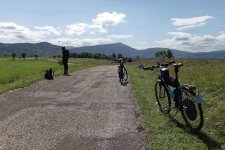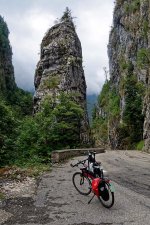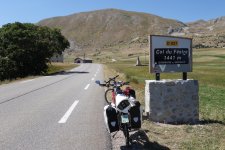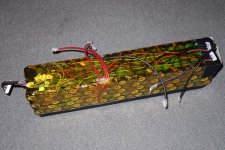For me efficency is the key to success.
Start with a lightweigt bike, add tires with low rolling resistance, try to keep air resistance low, try to keep the weight low.
I now use a 13s9p battery made from LG MJ1 cells, that's around 1.4kWh
Drive is a BionX D which is lightweight cmpared to its power and regen works very well for me.
Some ultralight camping gear helps to keep volume and weight down, so incl some food and repair stuff for the bike (I even carry a spare BMS and a small bhutane powered soldering iron) usually easily fits into 40l of storage today.
Our ebikes for long distance travelling are "speed pedelec" with a motor that supports up to 45km/h.
In real use consumption is typically around 7Wh/km, which gives a distance of up to 200km. Amazingly it's quite similar in mountainous and flat terrain. On mountain roads we need more human power, do benefit from regen downhill and are usually slower, in flat terrain speed is higher and so is air resistance.
In Europe you will almost always find a plug within 200km. As I get older I do prefer a shower before sleeping, so often we use camp sites for camping anyway and they almost always do have electricity.
We use cycle satiators and 360W is good enough to charge overnight (and often the evening is enough), but for quick charging a small and lightweight 1000W charger would be more interesting to us.
Weight of the e-bike is around 17kg, battery is around 6kg, charger 1kg+, spare parts and repair stuff around 1kg (needed only 1x for 2 people), lock is 1kg, camping geer depends on weather and type of travel is around 3-8kg/person and then you have some spare clothes and some food and water.
So overall the vehicle usually weights less than 40kg fully loaded.
the weight (incl rider) is low enough that the motor usually does not overheat, as long as you can maintain 20km/h+
To make the vehicle better for long distance a more areodnymanic 2nd grip option would be wise and a more aerodynamic way to store the stuff comapred to rear panniers (which are very pracitcal otherwise)
Bikes without luggage:


Bikes with lots of luggage (different tour):

Building the 13s9p battery for the BionX system. Also the battery has been optimized for minimal size and low weight:

From the star: Always try to use the samllest on most lightweigt option that is still usably to you and that you can afford. Driving around a 40kg ebike fully loaded usually make things a lot less complicated than touring with a 100kg setup and huge air resistance.








